Abstract
OBJECTIVE: To investigate the role of low serum magnesium as a trigger for atrial fibrillation in patients with a substrate for the arrhythmia (assessed by signal averaged P wave duration). DESIGN: A case-control study. SETTING: A regional referral cardiac centre. PATIENTS AND INTERVENTIONS: 105 consecutive patients undergoing elective coronary artery bypass surgery had signal averaged P wave recordings before operation. Serum electrolytes were analysed preoperatively and on days 1, 2, and 5 after surgery. MAIN OUTCOME MEASURES: Any episode of electrocardiographically recorded atrial fibrillation was taken as a study end point. RESULTS: Of 102 patients discharged, 27 (26%) had documented episodes of atrial fibrillation at a mean of 2.7 days after surgery. A combination of P wave duration > 155 ms and serum magnesium on the first postoperative day of < 0.7 mmol/l had a sensitivity of 75% and specificity of 80% for predicting atrial fibrillation. Duration of hospital stay (7.9 v 6.8 days) was longer in the atrial fibrillation group (P < 0.01). Stepwise regression showed age, serum magnesium < 0.7 mmol/l on the first postoperative day (both P < 0.001), angiotensin converting enzyme inhibitor withdrawal (P < 0.02), and signal averaged P wave duration (P = 0.04) to be independent predictors. CONCLUSIONS: The combination of signal averaged P wave duration and low serum magnesium on the first postoperative day identified the majority of patients with atrial fibrillation after coronary artery bypass surgery. Early identification and pharmacological treatment for selected patients may reduce the incidence of postoperative atrial fibrillation.
Full text
PDF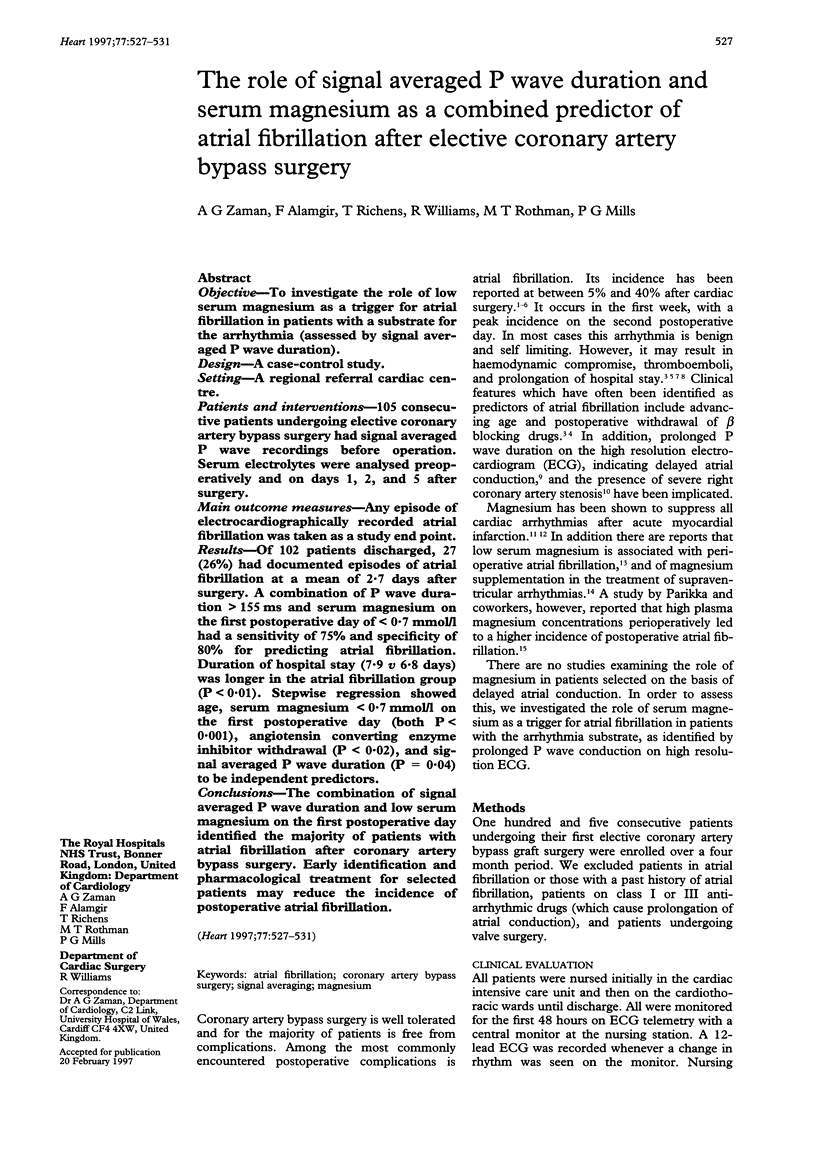
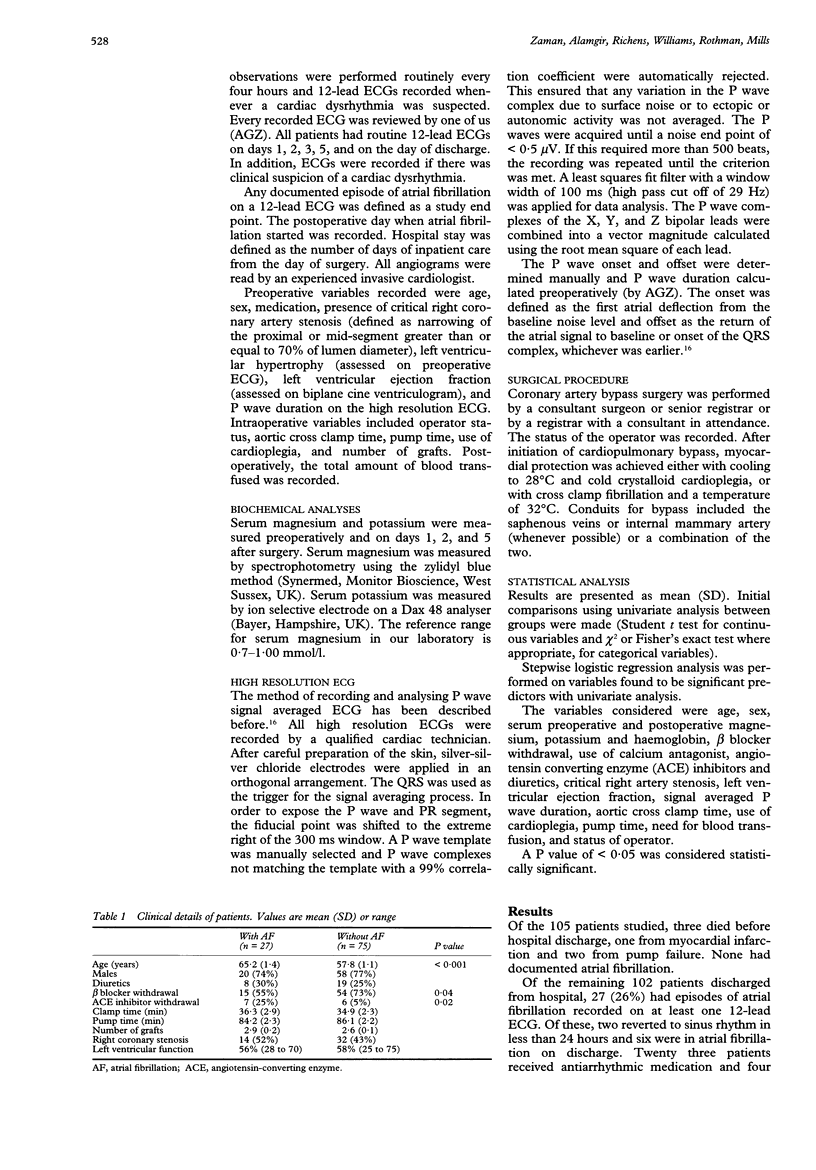
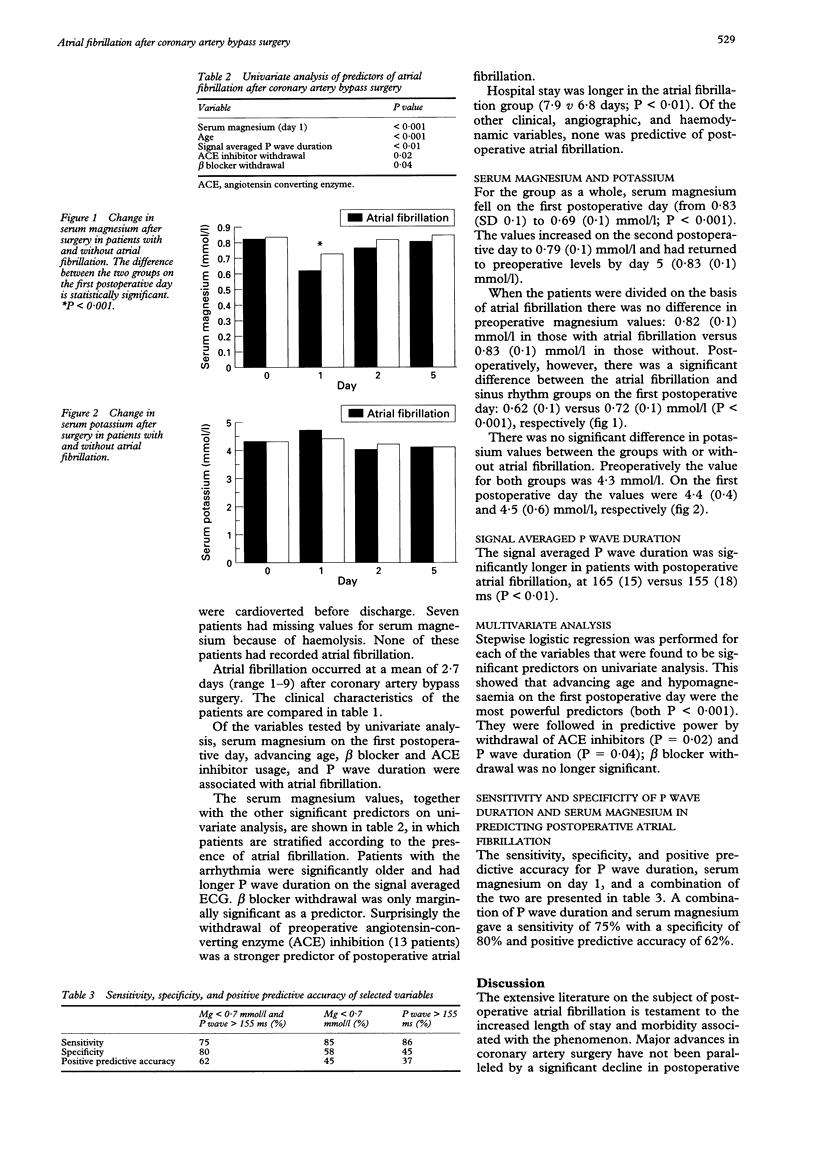
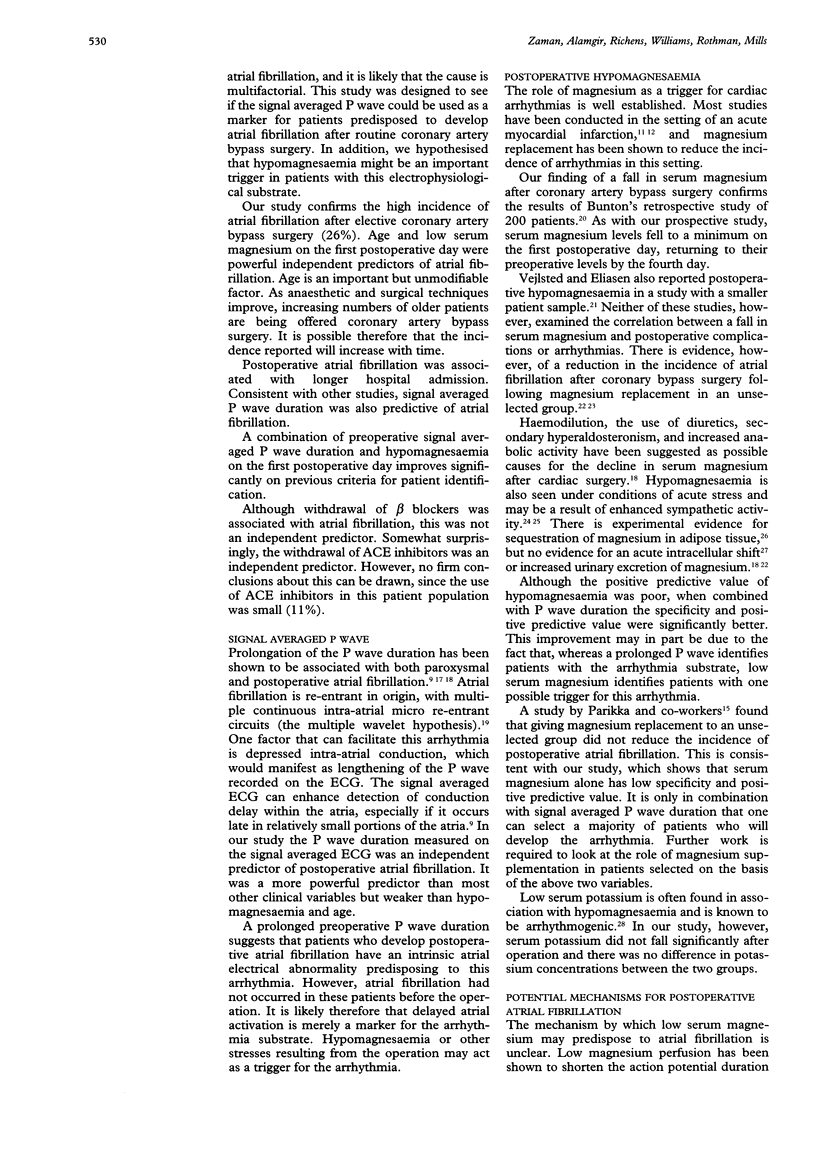
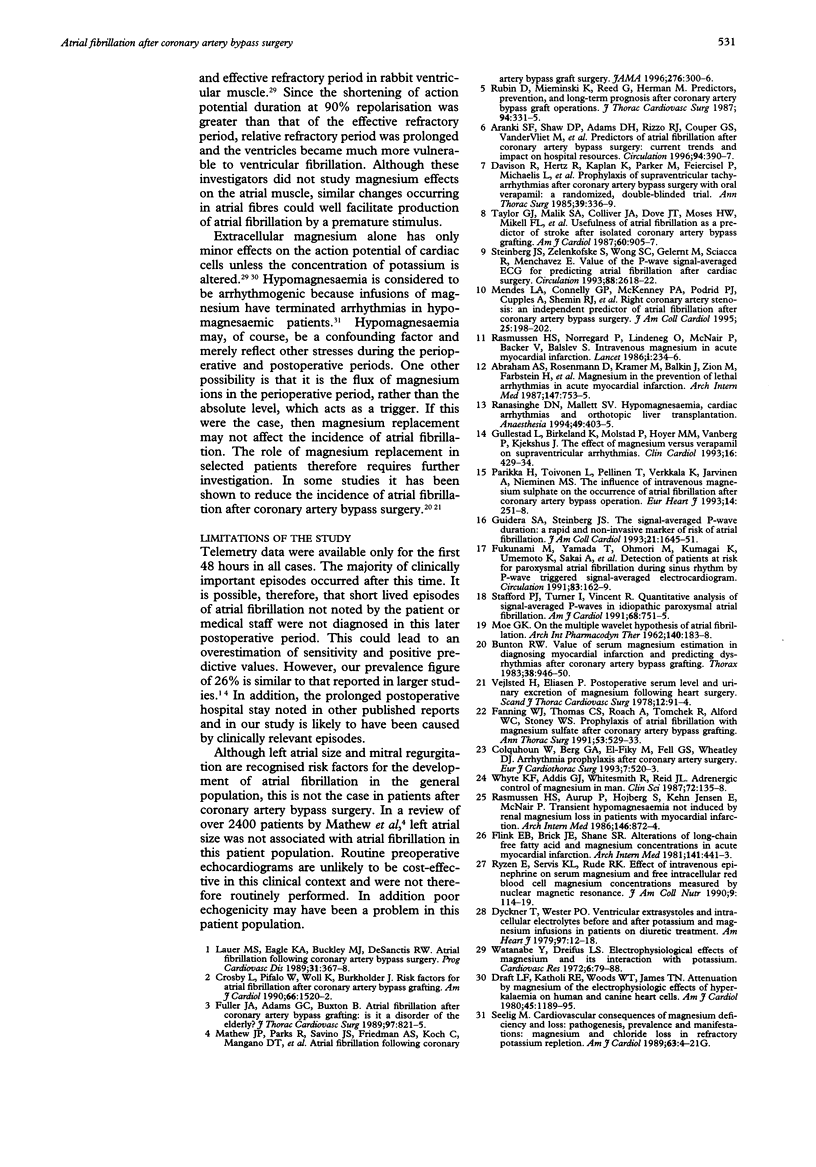
Selected References
These references are in PubMed. This may not be the complete list of references from this article.
- Abraham A. S., Rosenmann D., Kramer M., Balkin J., Zion M. M., Farbstien H., Eylath U. Magnesium in the prevention of lethal arrhythmias in acute myocardial infarction. Arch Intern Med. 1987 Apr;147(4):753–755. [PubMed] [Google Scholar]
- Aranki S. F., Shaw D. P., Adams D. H., Rizzo R. J., Couper G. S., VanderVliet M., Collins J. J., Jr, Cohn L. H., Burstin H. R. Predictors of atrial fibrillation after coronary artery surgery. Current trends and impact on hospital resources. Circulation. 1996 Aug 1;94(3):390–397. doi: 10.1161/01.cir.94.3.390. [DOI] [PubMed] [Google Scholar]
- Bunton R. W. Value of serum magnesium estimation in diagnosing myocardial infarction and predicting dysrhythmias after coronary artery bypass grafting. Thorax. 1983 Dec;38(12):946–950. doi: 10.1136/thx.38.12.946. [DOI] [PMC free article] [PubMed] [Google Scholar]
- Colquhoun I. W., Berg G. A., el-Fiky M., Hurle A., Fell G. S., Wheatley D. J. Arrhythmia prophylaxis after coronary artery surgery. A randomised controlled trial of intravenous magnesium chloride. Eur J Cardiothorac Surg. 1993;7(10):520–523. doi: 10.1016/1010-7940(93)90049-h. [DOI] [PubMed] [Google Scholar]
- Crosby L. H., Pifalo W. B., Woll K. R., Burkholder J. A. Risk factors for atrial fibrillation after coronary artery bypass grafting. Am J Cardiol. 1990 Dec 15;66(20):1520–1522. doi: 10.1016/0002-9149(90)90550-k. [DOI] [PubMed] [Google Scholar]
- Davison R., Hartz R., Kaplan K., Parker M., Feiereisel P., Michaelis L. Prophylaxis of supraventricular tachyarrhythmia after coronary bypass surgery with oral verapamil: a randomized, double-blind trial. Ann Thorac Surg. 1985 Apr;39(4):336–339. doi: 10.1016/s0003-4975(10)62626-4. [DOI] [PubMed] [Google Scholar]
- Dyckner T., Wester P. O. Ventricular extrasystoles and intracellular electrolytes before and after potassium and magnesium infusions in patients on diuretic treatment. Am Heart J. 1979 Jan;97(1):12–18. doi: 10.1016/0002-8703(79)90108-x. [DOI] [PubMed] [Google Scholar]
- Fanning W. J., Thomas C. S., Jr, Roach A., Tomichek R., Alford W. C., Stoney W. S., Jr Prophylaxis of atrial fibrillation with magnesium sulfate after coronary artery bypass grafting. Ann Thorac Surg. 1991 Sep;52(3):529–533. doi: 10.1016/0003-4975(91)90918-g. [DOI] [PubMed] [Google Scholar]
- Flink E. B., Brick J. E., Shane S. R. Alterations of long-chain free fatty acid and magnesium concentrations in acute myocardial infarction. Arch Intern Med. 1981 Mar;141(4):441–443. [PubMed] [Google Scholar]
- Fukunami M., Yamada T., Ohmori M., Kumagai K., Umemoto K., Sakai A., Kondoh N., Minamino T., Hoki N. Detection of patients at risk for paroxysmal atrial fibrillation during sinus rhythm by P wave-triggered signal-averaged electrocardiogram. Circulation. 1991 Jan;83(1):162–169. doi: 10.1161/01.cir.83.1.162. [DOI] [PubMed] [Google Scholar]
- Fuller J. A., Adams G. G., Buxton B. Atrial fibrillation after coronary artery bypass grafting. Is it a disorder of the elderly? J Thorac Cardiovasc Surg. 1989 Jun;97(6):821–825. [PubMed] [Google Scholar]
- Guidera S. A., Steinberg J. S. The signal-averaged P wave duration: a rapid and noninvasive marker of risk of atrial fibrillation. J Am Coll Cardiol. 1993 Jun;21(7):1645–1651. doi: 10.1016/0735-1097(93)90381-a. [DOI] [PubMed] [Google Scholar]
- Gullestad L., Birkeland K., Mølstad P., Høyer M. M., Vanberg P., Kjekshus J. The effect of magnesium versus verapamil on supraventricular arrhythmias. Clin Cardiol. 1993 May;16(5):429–434. doi: 10.1002/clc.4960160512. [DOI] [PubMed] [Google Scholar]
- Lauer M. S., Eagle K. A., Buckley M. J., DeSanctis R. W. Atrial fibrillation following coronary artery bypass surgery. Prog Cardiovasc Dis. 1989 Mar-Apr;31(5):367–378. doi: 10.1016/0033-0620(89)90031-5. [DOI] [PubMed] [Google Scholar]
- Mathew J. P., Parks R., Savino J. S., Friedman A. S., Koch C., Mangano D. T., Browner W. S. Atrial fibrillation following coronary artery bypass graft surgery: predictors, outcomes, and resource utilization. MultiCenter Study of Perioperative Ischemia Research Group. JAMA. 1996 Jul 24;276(4):300–306. [PubMed] [Google Scholar]
- McKenna W. J., Chetty S., Oakley C. M., Goodwin J. F. Arrhythmia in hypertrophic cardiomyopathy: exercise and 48 hour ambulatory electrocardiographic assessment with and without beta adrenergic blocking therapy. Am J Cardiol. 1980 Jan;45(1):1–5. doi: 10.1016/0002-9149(80)90212-x. [DOI] [PubMed] [Google Scholar]
- Mendes L. A., Connelly G. P., McKenney P. A., Podrid P. J., Cupples L. A., Shemin R. J., Ryan T. J., Davidoff R. Right coronary artery stenosis: an independent predictor of atrial fibrillation after coronary artery bypass surgery. J Am Coll Cardiol. 1995 Jan;25(1):198–202. doi: 10.1016/0735-1097(94)00329-o. [DOI] [PubMed] [Google Scholar]
- Parikka H., Toivonen L., Pellinen T., Verkkala K., Järvinen A., Nieminen M. S. The influence of intravenous magnesium sulphate on the occurrence of atrial fibrillation after coronary artery by-pass operation. Eur Heart J. 1993 Feb;14(2):251–258. doi: 10.1093/eurheartj/14.2.251. [DOI] [PubMed] [Google Scholar]
- Ranasinghe D. N., Mallett S. V. Hypomagnesaemia, cardiac arrhythmias and orthotopic liver transplantation. Anaesthesia. 1994 May;49(5):403–405. doi: 10.1111/j.1365-2044.1994.tb03472.x. [DOI] [PubMed] [Google Scholar]
- Rasmussen H. S., Aurup P., Hojberg S., Jensen E. K., McNair P. Magnesium and acute myocardial infarction. Transient hypomagnesemia not induced by renal magnesium loss in patients with acute myocardial infarction. Arch Intern Med. 1986 May;146(5):872–874. doi: 10.1001/archinte.146.5.872. [DOI] [PubMed] [Google Scholar]
- Rasmussen H. S., McNair P., Norregard P., Backer V., Lindeneg O., Balslev S. Intravenous magnesium in acute myocardial infarction. Lancet. 1986 Feb 1;1(8475):234–236. doi: 10.1016/s0140-6736(86)90773-7. [DOI] [PubMed] [Google Scholar]
- Rubin D. A., Nieminski K. E., Reed G. E., Herman M. V. Predictors, prevention, and long-term prognosis of atrial fibrillation after coronary artery bypass graft operations. J Thorac Cardiovasc Surg. 1987 Sep;94(3):331–335. [PubMed] [Google Scholar]
- Ryzen E., Servis K. L., Rude R. K. Effect of intravenous epinephrine on serum magnesium and free intracellular red blood cell magnesium concentrations measured by nuclear magnetic resonance. J Am Coll Nutr. 1990 Apr;9(2):114–119. doi: 10.1080/07315724.1990.10720359. [DOI] [PubMed] [Google Scholar]
- Steinberg J. S., Zelenkofske S., Wong S. C., Gelernt M., Sciacca R., Menchavez E. Value of the P-wave signal-averaged ECG for predicting atrial fibrillation after cardiac surgery. Circulation. 1993 Dec;88(6):2618–2622. doi: 10.1161/01.cir.88.6.2618. [DOI] [PubMed] [Google Scholar]
- Taylor G. J., Malik S. A., Colliver J. A., Dove J. T., Moses H. W., Mikell F. L., Batchelder J. E., Schneider J. A., Wellons H. A. Usefulness of atrial fibrillation as a predictor of stroke after isolated coronary artery bypass grafting. Am J Cardiol. 1987 Oct 1;60(10):905–907. doi: 10.1016/0002-9149(87)91045-9. [DOI] [PubMed] [Google Scholar]
- Vejlsted H., Eliasen P. Postoperative serum level and urinary excretion of magnesium following heart surgery. Scand J Thorac Cardiovasc Surg. 1978;12(2):91–94. doi: 10.3109/14017437809100355. [DOI] [PubMed] [Google Scholar]
- Watanabe Y., Dreifus L. S. Electrophysiological effects of magnesium and its interactions with potassium. Cardiovasc Res. 1972 Jan;6(1):79–88. doi: 10.1093/cvr/6.1.79. [DOI] [PubMed] [Google Scholar]
- Whyte K. F., Addis G. J., Whitesmith R., Reid J. L. Adrenergic control of plasma magnesium in man. Clin Sci (Lond) 1987 Jan;72(1):135–138. doi: 10.1042/cs0720135. [DOI] [PubMed] [Google Scholar]


